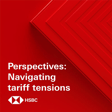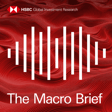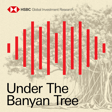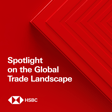Become a Creator today!Start creating today - Share your story with the world!
Start for free
00:00:00
00:00:01

Under the Banyan Tree - Asian tariffs in perspective
Fred Neumann is joined by fellow economists Jing Liu, Pranjul Bhandari and Aris Dacanay to tease out the nuances of US trade tariffs across Asia, with a focus on China, India, Indonesia, Thailand and the Philippines..
Disclaimer: https://www.research.hsbc.com/R/101/CNSfvhT. Stay connected and access free to view reports and videos from HSBC Global Research follow us on LinkedIn https://www.linkedin.com/feed/hashtag/hsbcresearch/ or click here: https://www.gbm.hsbc.com/insights/global-research.
Transcript
Introduction to HSBC Global Viewpoint Podcast
00:00:01
Speaker
Welcome to HSBC Global Viewpoint, the podcast series that brings together business leaders and industry experts to explore the latest global insights, trends, and opportunities.
00:00:13
Speaker
Make sure you're subscribed to stay up to date with new episodes. Thanks for listening, and now onto today's show.
00:00:24
Speaker
This is a podcast from HSBC Global Research, available on Apple Podcasts and Spotify. However you're listening, analyst notifications, disclosures and disclaimers must be viewed on the link attached to your media player.
Guest Introduction: Economic Experts Panel
00:00:45
Speaker
Welcome to Under the Banyan Tree, where we put Asian markets in the economics in context. I'm Fred Newman, Chief Asia Economist here at HSBC in Hong Kong. Now, as the region in the world digests the reality of the global trade shaker, we want to take a closer look at the nuances of US tariffs on Asia. My guests today are Chief China Economist Jing Liu, Chief Economist for India and Indonesia Pranjubandari, and ASEAN Economist Doris Dakenay.
00:01:12
Speaker
Let's get the conversation started right here Under the Banyan Tree.
How Do US Tariffs Affect Asian Economies?
00:01:26
Speaker
So trade, trade, trade, still the number one headline right now. Changes to U.S. trade policy and implications for economies far and wide, particularly here in Asia. Asia's economies are very much manufacturing, export-centered. Many have built their growth record in recent decades on expanding, really, the export sector.
00:01:48
Speaker
And it's also Asia that received among the highest tariffs from the reciprocal terror scheme in the United States. ah It's still a fast evolving situation, but already what we know date suggests that Asia will be left with substantially higher tariffs than we had just a few weeks ago.
00:02:08
Speaker
And that will, of course, impact exports, but not just exports, also investment. And with that, employment, for example, So in many economies, this is a severe headwind for economic growth.
00:02:21
Speaker
At the same time, it's also important to keep things a little bit in perspective. If you just keep an eye on financial markets, you might conclude this is sort of a bit of the end of the world, quote unquote, in that sense that markets are very volatile indeed.
00:02:37
Speaker
And there's almost as if you see a sea of red across your trading screens, markets are down. You might conclude that really we're headed for a deep, deep recession. But what we wanted to do today is really talk to three experts and tease out some of the nuances. Because while there' this is really a sea change in how we should think about Asian growth, and while it is a major headwind for ah these economies.
00:03:01
Speaker
There is also much else going for these economies. We have domestic ah markets that are very large with three and a half billion consumers across the region, if not more.
00:03:12
Speaker
There's still a lot of pent-up demand. um This is about re-tweaking Asia's growth model, perhaps, and in that sense um it's not the end of the world. It just means a change in growth strategies across Asia. But we wanted to delve a little bit deeper and look at individual economies. And let me bring in Jing Liu, our chief China
China's Response to US Tariffs: Domestic Consumption's Role
00:03:31
Speaker
economist. Jing, we have to start with China.
00:03:34
Speaker
It is ah front and center here. are We're looking at, as at a time of recording, total tariffs imposed by the U.S. on China might be in excess of 120% all in if we include tariffs that were imposed by during the first Trump administration, this surely, surely must mean a severe hit to China's exports to the United States.
00:03:58
Speaker
Yes, certainly. And to be honest, at that high level, it's already prohibitive. Let's say if it further escalate from here, i think the effect is more or less the same.
00:04:10
Speaker
because the terrorist levels are so high, so it doesn't matter at some point whether it's 120% 200% or 300%, at some point these goods just become much more ah expensive in the United States, reducing demand for Chinese exports. But um how important really are exports from China to the United States for the Chinese economy. We tend to think of China as being an export powerhouse, but it's a very large domestic economy as well. So can you give us a sense of how important this actually is for China's economy? Can China live without exports to the United States?
00:04:44
Speaker
Well, I think the short answer is yes. Basically, benefiting from your calculation, ah the value-added perspective export to the U.S. account for about 2.5% of China's GDP.
00:04:58
Speaker
So technically speaking, without that 2.5%, China's China actually managed to beef up the domestic consumption, there is still decent growth coming from China.
00:05:11
Speaker
So that means 97.5% of China's economy is not dependent on the US. So ah that would mean you lose 2.5% of your GDP, worst case. um Would hurt in the short term, but medium term, surely China can live with that. That's the message you have.
00:05:28
Speaker
Yes, that's right. But I surely hope there's no decoupling between US and China. And I still believe there's a good chance that both sides will get back to the negotiation table.
00:05:39
Speaker
um So that is, i guess, ah the hope right now that we see financial markets, investors, business people still hoping that the door is slightly ajar for a deal here between China and the US.
00:05:51
Speaker
I think we should also mention that actually during the first Trump administration, things looked also very dire at some point. There was a lot of tensions, talk about trade and retaliation, so forth.
00:06:03
Speaker
But ultimately, they came up with a phase one deal, what was called at that time, and that kind of put a hold on everything. So I think we shouldn't entirely rule out and the potential of some sort of compromise here, which will probably dampen, cushion the impact
India's Economic Strategy: High Tariffs and Service Exports
00:06:17
Speaker
a little bit. But let me bring in Pranjul Bhandari, our chief economist for India and Indonesia.
00:06:23
Speaker
Pranjul, the Indian economy has received quite high tariffs as well, reciprocal tariffs. Maybe remind us how high they are. But on the other hand, exports to the U.S. not quite as important for the Indian economy overall. Is that correct?
00:06:40
Speaker
Yeah, so look, there's been a 26% tariff levied on India, um and I think that is meaningful. And there will definitely be a growth hit on the economy in 2025. But I really want to take a step back here and talk about a few offsets and exemptions that are also in play, which could soften the blow.
00:06:58
Speaker
I think one thing that stands out for me is that today, 50% of India's exports is actually services, and there are no tariffs on services. So that remains completely exempt. And even in the goods exports, some important sectors like pharmaceutical, at least for now, is exempted. So I think that could soften the blow.
00:07:16
Speaker
Also, there's a lot of policy response that the government is doing and can do. You know, inflation has fallen quite a lot. The central bank is easing monetary policy fairly aggressively, I would say.
00:07:28
Speaker
And that is something that could help growth. Fiscal deficit is quite low. So there is some fiscal space. The government has fiscal space to increase spending. It has a very nice digital payments infrastructure, so it can actually increase fiscal sales spending pretty quickly.
00:07:43
Speaker
And then finally, I must talk about domestic consumption in India. And an important part of that is rural consumption, which was weak for two years in a row because of bad weather. but it's actually picking up quite a lot now. There's been back-to-back great harvests, and I think that could cushion you know some of the negative impact of the tariffs.
00:08:02
Speaker
Now, that's interesting. You talk about some of the offsets, fiscal policy, for example, the fact that not all Indian experts to the United States face these terrors partly because of pharmaceuticals or services, for example.
00:08:14
Speaker
Is there also a sense in India that maybe this is an opportunity in disguise? it's a weld It's a good disguise, we should say, because of course the way markets have reacted, it's not necessarily means that investors are taking the glass half full approach here. But if we kind of think about um You mentioned so tariffs in the 20%. That's lower than for some other countries in Asia, notably Vietnam, 46%, for example. We talked about China. We're looking at over 120%.
00:08:44
Speaker
Is there a sense that maybe maybe some industries might move to India, kind of rerouting maybe? ah and And also, does the tariff threat in the United States spur also the government towards greater reforms, which ultimately would be good as well?
00:09:00
Speaker
Yeah, I'm so glad you brought that up because I think for the first time in many years, I can see India doing a couple of external sector reforms. It's fast tracking a lot of the trade agreements. For example, it wants to have a bilateral trade agreement with the United States of America by fall, with EU by the end of the year.
00:09:18
Speaker
It's been cutting a lot of the tariffs and non-tariffs barriers in the last six months or so. It's becoming more welcoming of regional FDI, ah which I think is something that was not in the picture in the last couple of years.
00:09:31
Speaker
And finally, it's allowing the rupee to be a lot more flexible than before, which I think is great for openness and trade over the medium term. So my sense is that while in the short run, there is obviously a growth track, but I think in a one year horizon, things could start looking quite interesting and maybe even positive for India if it can attract a lot of the FDI in especially mid-tech sectors like textiles and then export to other economies with whom they would have just had new trade deals.
00:10:01
Speaker
So some hope there that in India, maybe there could be some benefits down the road, although I think, of course, in the near term, the uncertainty weighs on everybody. But, you know, often in these types of environments, we have to look past the market volatility and the confidence shock. You know, the world will look different in a few months from now. And so that's why ah think, um you know, your point is well taken on the fact that there are some opportunities there.
00:10:25
Speaker
for India. But Aris, let me bring you in here. um You cover you know economies like Thailand and the Philippines, for example.
Thailand's Export Challenges Amid US-China Trade Shifts
00:10:33
Speaker
a lot has been said about Vietnam being particularly badly impacted because the tariffs are very high and it exports a lot of goods. But talk to us about Thailand, because um Thailand is still a major exporter in its own right. Yes, it has a tourism sector. and We know that's very important for the economy.
00:10:50
Speaker
But Thailand is still a major exporter, but including to the United States. So how big a hit is this for for Thailand? So let's just provide a few numbers for 2024. Thailand... for thailand 18.3% of its total exports is to the U.S. The U.S. is Thailand's largest export destination. And as a percent of GDP, exports to the U.S. represent around 10%.
00:11:12
Speaker
So it's massive. um But the thing is, it's going to be tough for Thailand because it's going to hit Thailand in different directions. One direct demand from the U.S. It has 36% tariff as a point of this recording.
00:11:26
Speaker
um You have, for example, the Philippines being taxed less. Of course, there's less demand in the U.S. and there's also substitution effect. um The Philippines and Thailand, they represent, or at least their top exports to the U.S. is the same thing.
00:11:41
Speaker
It's semis and electronics parts. So if you could buy it cheaper elsewhere, you're going to move your demand, let's say, from Thailand to the Philippines or to other areas in ASEAN. The other direction that I guess needs you know we need to worry about is overcapacity issues from the rest of the world.
00:11:57
Speaker
And I guess um one point of focus is China. Thailand was directly affected by by the high inventory levels in China because Thailand produces the same thing as China.
00:12:10
Speaker
The number two HDD producer in the world, Thailand. HDD being hard describes. Number one, China. and The largest car manufacturer in ASEAN is Thailand. The fourth largest in Asia is Thailand.
00:12:23
Speaker
Top there is China. um And Thailand doesn't have the capacity yet to produce EVs. So if China gets tariffed by, let's say, I mean, 100%, a lot of these exports that that China produces may as well go to growing areas of the world. And what is the second fastest region in the world in terms of growth? It's ASEAN.
00:12:47
Speaker
So this redirection, change in direction of Chinese exports might be a blow to Thailand. So that's interesting. You talk about trade diversion here, um which is if the U.S. doesn't buy Chinese goods because the tariffs are too high, then Chinese exporters will look elsewhere.
00:13:02
Speaker
and then make life hard for a domestic producer in Thailand if Thailand gets swamped with imports from China as a result. and And so that that's of course a risk for not just Thailand, but you'd say Korea, Europe, and other other the economies as well.
00:13:16
Speaker
But Jing, let me quickly bring you in here. um that Is that risk that essentially if China redirects exports elsewhere and that could raise kind of protectionist sentiment elsewhere, is that a risk Chinese leaders are aware of, thinking of, worried about?
00:13:32
Speaker
I think so, um because the head-to-head confrontation right now China has with the U.S., could be replayed elsewhere if China start to actually push the products elsewhere.
00:13:44
Speaker
So I think um this round of tariff also makes Chinese leaders reconsider the growth strategy. Domestically, we see there's already a pivot to stimulating consumption instead of stimulating production.
00:14:00
Speaker
ah We probably will see the step up of measures in the weeks, if not months ahead. And that can absorb some of the capacity ah previously oriented for export.
00:14:12
Speaker
And the next stage um is right now we see a lot of government, local government pushing for outbound direct investment. As long as we see there's more direct kind of investment to help, ah say, set up a factory in Thailand or elsewhere, hire the local workers, create GDP, I think the tension will be much lower.
00:14:37
Speaker
In my recent ah tour, ah to Beijing, I hear the Chinese officials say Japanese actually set good example how to achieve this mutually beneficial coexistence with the local community.
00:14:51
Speaker
That's a very interesting point. And and so of the the importance of increasing domestic demand in China is not just important to help China's own economy weather the growth shock from the tariffs in the US, but it's also, listening to ours, important to alleviate pressure on other countries that compete with China. So it's it's really for the sake of ah the global economy as well as for China's own economic sake that that we need to see more domestic demand. Maybe it's a great point to take a quick break. And when we come back, i want to ah dig a little bit deeper into ASEAN and talk specifically about Indonesia and the Philippines, which are, of course, two economies also caught up in this change of U.S.
Indonesia's High-Value Export Vulnerability
00:15:35
Speaker
s trade policy.
00:15:45
Speaker
Now we're back and we talked before the break, we talked about the importance of China to ramp up its domestic demand, not just for its own economic growth, but really to help the rest of the region. um But speaking of the rest of the region, I wanted to hone in a little bit on ASEAN, but two economies in particular, Indonesia, largest economy in Southeast Asia,
00:16:04
Speaker
Pranjul, you're the ah chief economist for Indonesia. Can you help us understand how vulnerable is Indonesia in this context? Because really, Indonesia i has seen very high tariffs, actually, but it's not a major exporter of manufactured goods to the United States, is it?
00:16:22
Speaker
Yeah, Fred, so look, there's been a 32% tariff slapped on Indonesia. You know, the exports to US is about 2% of GDP, and you can argue it's not a very high number. But if you actually break down what these exports really are, they're actually the more high, you know, value-added goods for Indonesia.
00:16:38
Speaker
yeah are things like textiles, electronics, footwear, furniture, sectors where Indonesia was just trying to grow faster and faster. So it's basically this diversified group that is going to you know get into some trouble now.
00:16:53
Speaker
The other point about Indonesia is that the starting point is not very strong. and Indonesia's growth has been a little weak over the last year. We've seen you know some of the PMI manufacturing indices dipping into the negative.
00:17:06
Speaker
So a delicate starting point means that the impact could be a little harsher. So i think for these reasons, I do think that the 32% tariff could hurt growth considerably. And you know monetary policy and fiscal policy will have to ease.
00:17:22
Speaker
So easing of of monetary and fiscal policy in Indonesia, Aris, um Philippines. There's a bit of excitement the Philippines, isn't there? Excitement, quote unquote, because the Philippines received lower tariffs than many of its Asian
Can the Philippines Leverage Reduced Tariffs?
00:17:36
Speaker
competitors. So is this ah the tariff that makes the Philippines great again?
00:17:42
Speaker
So that is, again, as indeed on the ground, people are a bit excited because I think people need to know that ASEAN, each individual country, exports the same thing to the U.S. The top exports to the U.S. is semis and electronics parts, or electronics in general.
00:17:58
Speaker
So there's a lot of room of substitutability. And these tariffs, again, that's the Philippines, the second lowest in Asia. um You have Vietnam at plus 40, Thailand at 36.
00:18:09
Speaker
So there's room for the Philippines to benefit when the Philippines, being taxed less, becomes more competitive. You tend to buy more U.S. s goods than everyone else. um So the Philippines benefits in a way that, one, there's more demand in a sense. Yes, there will be less trade, but more demand for Philippine-specific goods.
00:18:28
Speaker
But at the same time, the fact that you can be the channel to sell to the U.S., A lot of these high labor-intensive manufacturing sectors can easily relocate to the Philippines if they intend to be competitive and sell to the U.S. It's a big opportunity for the Philippines. So here an opportunity for the Philippines, an economy that has excelled in services exports and maybe now sees and just a slight chance of glimmer of hope there...
00:18:55
Speaker
to break into greater supply chain connectivity manufacturing exports. um But Pranju, that sounds great and and you touched a little bit on this. Presumably some of these benefits will only come through over time, ours um but in the near term there's still a lot of disruption also for Indonesia as you highlighted. so Pranju, as you see these drag the drag come into a place like Indonesia, how much scope is there really to cushion growth through say fiscal policy to provide a stimulus to offset this? Does Indonesia have the ability to kind of offer support to the economy to offset some of the drag?
00:19:33
Speaker
Well, look, it it did that a few years ago during the pandemic. ah You know, fiscal deficit is currently well below 3%. But if need be, you know, the 3% cap can be removed and higher fiscal deficit can be run. So there can be a lot of new expenditure.
00:19:48
Speaker
The new president has already announced new social welfare schemes. like free food for children, electricity tariff discounts. So, you know, he can he could just add to those. So I think there is room for fiscal easing.
00:19:59
Speaker
And in terms of monetary policy, inflation is extremely low. It's well below the two and a half percent inflation target. So there's a lot of scope for cutting rates. The only problem is the effects.
00:20:11
Speaker
You know, if you cut rates too quickly, then the currency can come under pressure. So the Bank Indonesia will have to just basically stagger it out and space it out. But over time, over one year, I think there can be quite a lot of rate cuts that could come through.
00:20:24
Speaker
So some cushion there from the policy side on fiscal and on on monetary as well. But Aris, listening to you, the Philippines probably doesn't need it if there is an opportunity, but Thailand probably would. Does Thailand have scope to ease policy and cushion the impact on its growth?
Thailand's Economic Dilemmas: Debt and Deficit
00:20:41
Speaker
So the answer is not really. but there's a big decision whether you want to rebalance these risks. um So what is the biggest risk? So Thailand has very high household debt. It its ah it is an over-leveraged economy.
00:20:55
Speaker
Household debt to GDP is around 90%, the highest amongst upper-middle income economies, and of course, the highest in ASEAN. Now, if you cut interest rates, you're basically incentivizing people to get more credit, to get more leverage, to boost the economy.
00:21:11
Speaker
But if you're at 90%, it's It's pretty tough. um Fiscally, you're also up near the fiscal deficit limit. um There's a statutory limit in Thailand of 70%. You're currently at 65%.
00:21:24
Speaker
So if you boost the economy fiscally, you might just touch that 70% and that's going to be a very difficult time. So that's some constraint there in Thailand. But I guess the good news for Thailand is that we didn't see any tariffs being put on tourists coming to Thailand. And and that's, of course, a very, very important part for the Thai economy.
00:21:43
Speaker
um Now, actually, if I can add to that, so because of the White Lotus, because of Lisa Manoban, personal recreation is actually growing by 300%. Okay, there you go. And this is maybe ah good note to end on because we have tremendous resilience in this region. So yes, some economies are a hit ah harder than others. We talked about Thailand, for example, and we talked about Indonesia, but we also have economies like the Philippines and India who maybe i see a bit of an opportunity
Asia's Growth Potential and Resilience
00:22:11
Speaker
here. So it is a varied picture, but overall,
00:22:14
Speaker
I think it's important to keep some of these tariffs and the impact in perspective. There is tremendous, tremendous growth potential in this region, probably more so than anywhere else in the world. and And so, yes, it might look scary if you look at your screens right now, but we've been through these episodes before and we'll come out on the other side stronger. i want to thank you for joining us. Thank you, Pranju. Thank you, Jing. And thank you, Aris.
00:22:36
Speaker
Pleasure to join you today, Fred. Great to be here. Thank you for having us. Well, folks, for more on the global trade shakeup, tune in also to our sister podcast, The Macro Brief.
00:22:48
Speaker
That's all we've got time for on this week's episode. Thank you very much for listening in. This story is not going to go away anytime as soon, and neither are we. We'll be back again next week putting Asian markets and economics in context.
00:23:00
Speaker
Talk to you then.
00:23:39
Speaker
Thank you for joining us at HSBC Global Viewpoint. We hope you enjoyed the discussion. Make sure you're subscribed to stay up to date with new episodes.
















